Limbo Learnings
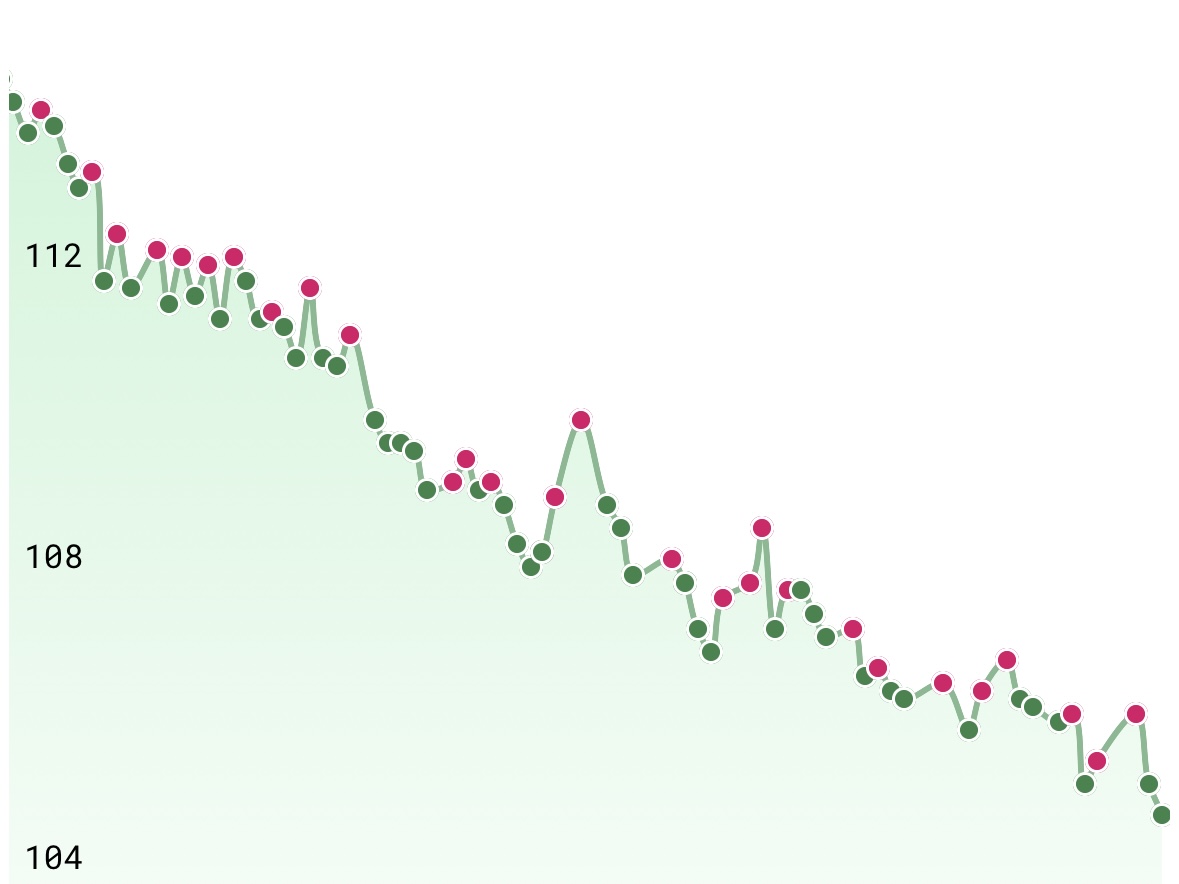
Following on from my first post about using Limbo to lose weight, I thought I could reflect on the past 3 months.
To recap, Limbo is an app based around a continuous blood glucose sensor, where the central premise is that removing glucose spikes leads to weight loss. Removing those spikes, broadly, means not eating carbohydrates leading to ketosis—where your body obtains energy from stored fat rather than expecting an intake on carbs to fuel it. If “ketosis” sounds a bit like “keto diet” then you’re in the right ballpark.
This is a long post broken down broadly into lessons I’ve learnt, the results I’ve achieved, and some closing thoughts about Limbo itself.
Education
Over the past 3 months, I’ve learnt a lot about food and studied more nutrition labels than in the rest of my life. It’s amazing the difference in seemingly similar foods. For example, did you know that Cannellini and Butter beans have drastically different amounts of carbs (40g/100g vs 7g!)? Or that cashew nuts have 30g/100g of carb but peanuts have 16g and walnuts only 13g?
I would also like to thank EU food regulators for requiring sensible food labels that list per 100g amounts and not just per-portion amounts. Our US cousins are at a significant disadvantage when comparing foods due to their poor and inconsistent labelling.
Sustainability
There’s some criticism that “this diet isn’t sustainable” and to me the obvious answer is “of course it’s not!”. I’m losing almost 1kg of weight each week so clearly this cannot continue because in a year I’d be dead! By definition, weight loss is not sustainable. But we know how to make it sustainable just by easing off the brakes a little: adding back some carbs, of smaller portions than previously, and indulging in the occasional treat that really is occasional and not every single evening.
I’m also aware that optimising for one thing (weight loss) often means some other aspect suffers. Eating more eggs can increase cholesterol, and eating more red meat might increase the risk of gout or even cancer in the long-term. Avoiding fruit completely cuts out important vitamins, and a reduced carbohydrate intake probably makes me more irritable and tired in the evenings.
Another aspect of sustainability is environmental. I don’t love that at a time when we are supposed to be going more vegetarian that my diet has switched to high-protein/low-carb and my meat consumption has increased. I guess eggs are pretty sustainable but it has been quite eye-opening to walk around the supermarket and reflect on just how much and how important carbohydrates are for feeding a population. Entire sections given over to fruit, potatoes, bread, rice, pasta, dairy, and more processed forms of carbs in the treat isles and freezer sections. The world really is fed on carbs and I suspect a high-protein/low-carb would not be possible for a large proportion of the population. I feel a bit guilty and privileged by that.
Breakfast ideas
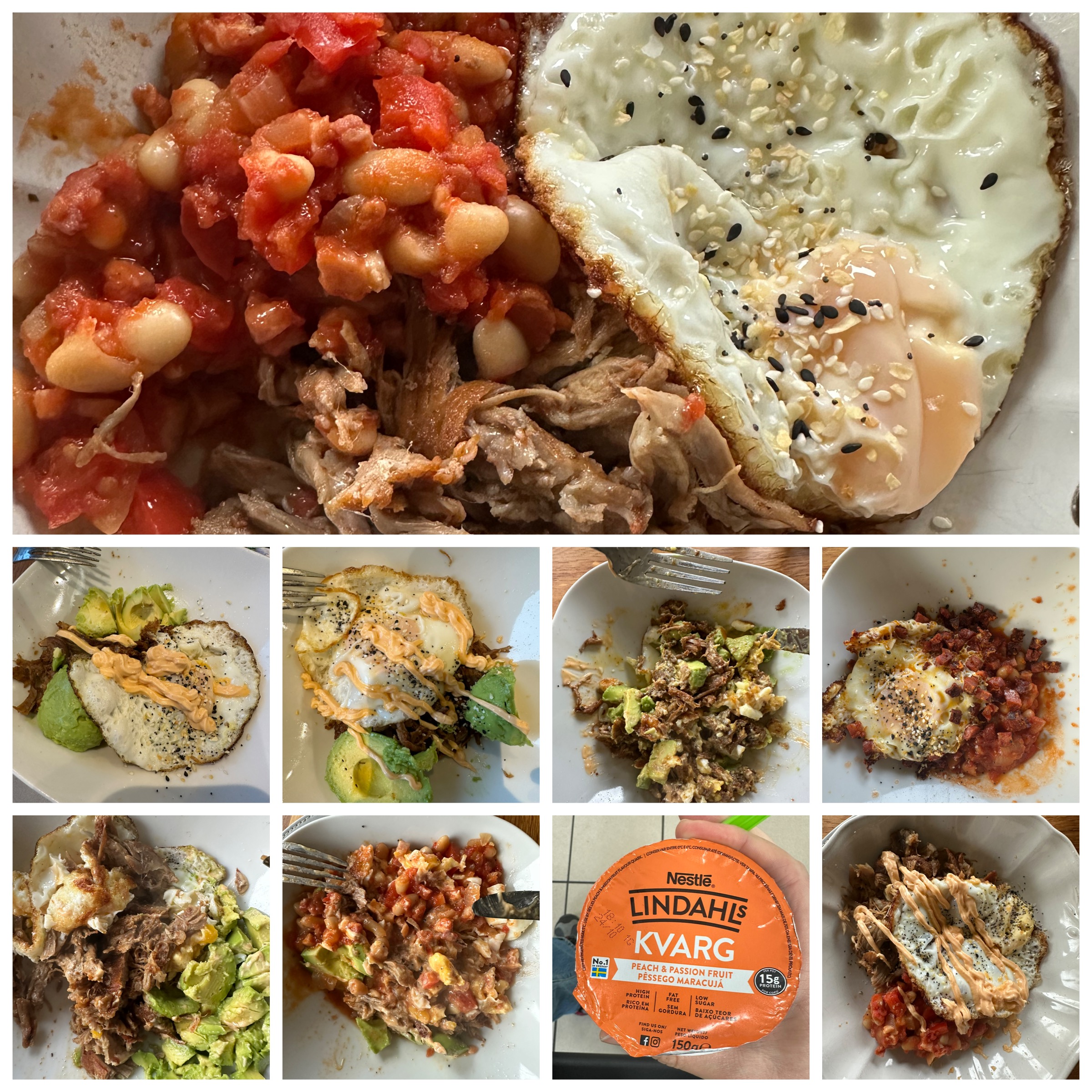
Breakfast is probably the hardest meal to adapt to since many of us are using to some combination of cereal and fruit. Out went the granola, yogurt, and fruit; in came some combination of meat (pulled Pork, chorizo, bacon), homemade beans, avocado, and egg.
Pulled pork
There’s a million ways to cook this, particularly if you have an Instant Pot but you can also buy it in a bag from the supermarket and cook it in the oven for ~2 hours. If cooked on a Sunday it’ll provide breakfast for the week
Baked eggs in air fryer
One egg in a ramekin, gently stir a dribble of milk into the white, add ham/chorizo. Sprinkle with cheese, 8-9mins at 160°C.
Frittata
Frittatas are a good high-protein breakfast (or lunch or dinner) and unlike quiche they don’t have any high-carb pastry.
- Whisk 5 eggs with about 100ml of double cream
- Fry up some bacon bits or chorizo or pepperoni etc, along with some onions and peppers (or other veg).
- Pour the egg/cream mixture into a cast-iron pan and cook for ~5mins, then transfer to the oven for about 10mins until golden brown.
Can also be made in the air fryer in a silicone mould or dish
Breakfast beans
Heinz baked beans are too high in carbs but you can make your own and with a bit of experimentation get a result to suit you.
- Fry off some chorizo or bacon, then remove from the heat
- Fry garlic (3 cloves, grated) and an onion, maybe a pepper too
- Add a tin of chopped tomatoes, a half pint of veg stock, and the fried bacon.
- Add 2x tins of Haricot beans (or Cannellini)
- Simmer until it reduces
It can be made and eaten in under 20 mins and it’s basically all protein. Makes enough for 4-5 days and keeps in the fridge.
I found that a large spoon of these beans with a fried egg provided a satisfying breakfast. I need to be careful not to eat too much of them or it would cause a glucose spike
Low-carb protein yogurts
The Lindahl yogurt range is a good breakfast (with 3-4 blackberries) if you need something faster / lighter and a luxurious treat at other times. I found that I needed to be extra careful of any berries added as my blood glucose was much more susceptible to spiking early in the morning.
It’s also a great fill-in if I’ve eaten lunch at 12 and have meetings until ~7, or I’m going swimming after work and won’t eat dinner til 8-9pm. The Stracciatella one is a huge treat for the chocolate-starved with tiny pieces of cocoa and only ~3.5g/100g of carbs.
These yogurts seems to be widely available in Dunnes, Supervalu and even Circle-K service stations.
Snacks
Dry roasted peanuts were a surprisingly good snack at the cinema and various selections of nuts are available at service stations. Just watch the carbs because not all nuts are equals and any honey-roasted or BBQ flavouring is probably carb-rich.
Eating out / Takeaway
Nando’s is a pretty easy option to eating out: lots of chicken, broccoli, peas etc. It’s easy to leave the chips out but the sweet potato is tempting (but bad for your glucose).
We’ve had takeaways a few times with varying levels of success at preventing glucose spikes.
- Tandoor mixed platter from an Indian was really good but then it was basically all meat & a bit of veg
- Satay chicken is usually available as a starter and is a good way to add extra protein to a main course
- Takeaways will often insist on giving you rice/chips/noodles for a main course so I foist these on the kids or just dump them
- Italian restaurants are probably the hardest because they’re based around pizza & pasta. Caprese salad or Burrata is a good started and they will sometimes have grilled meat available for main course.
Electrolytes
I found myself getting quite dehydrated and having some negative effects like low blood pressure, high heart rate etc. Drinking a pint of electrolytes with a salt replacement tends to help
Cheesecake?
I haven’t figure out a base that worked well but the filling makes a good snack if you need it. Just make up a packet of sugar-free jelly, fold in cream cheese, and add about 100ml of double cream. It’s weird, pink, and wobbly—but very filling.
Typical lunch
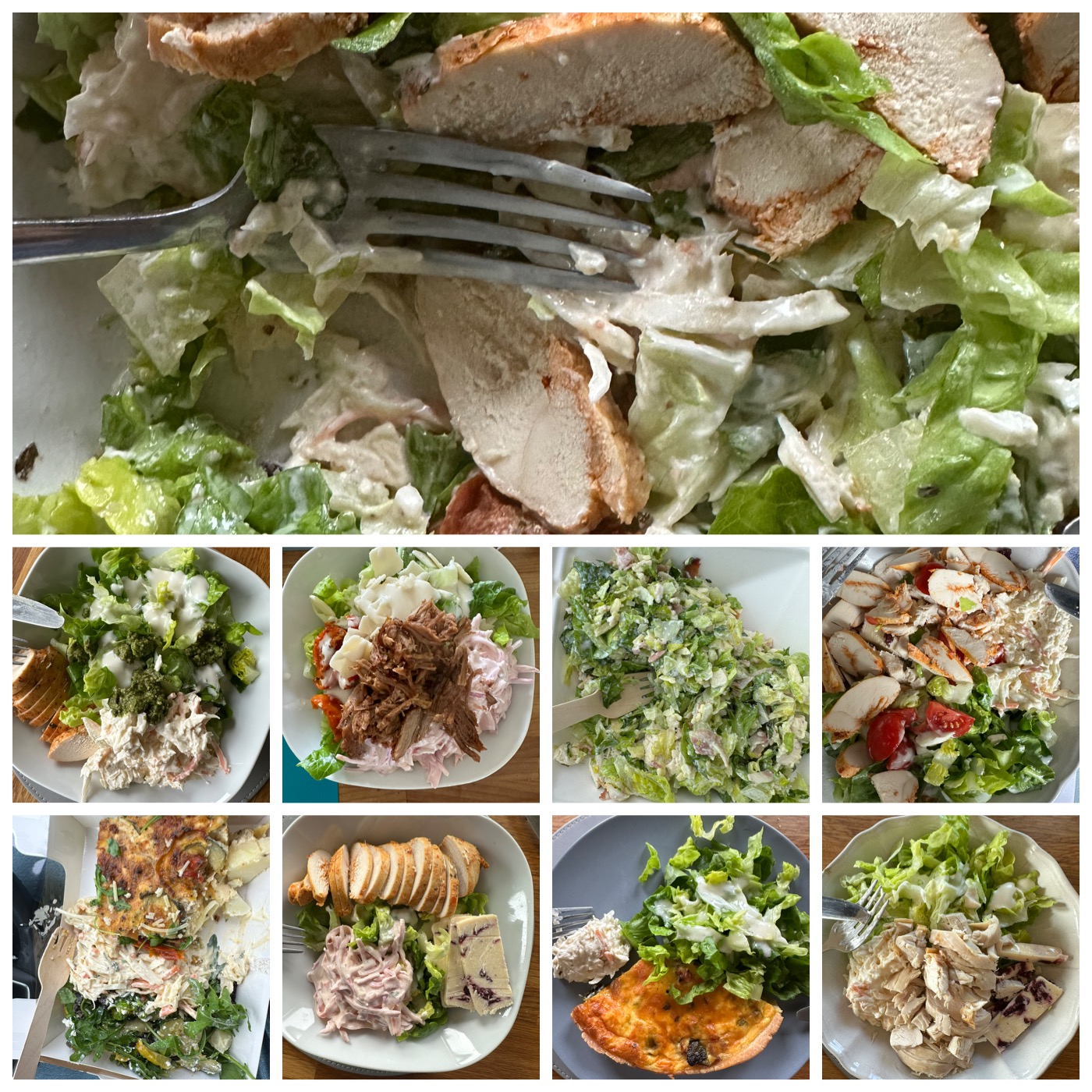
I mostly eat a protein-heavy salad for lunch. For example, a whole head of Cos lettuce, a whole chicken breast (or meatballs, or some leftover meat), slices of cheese (mostly Wensleydale with cranberries), coleslaw, some Caesar salad dressing. Sometimes I add sun-dried tomatoes, fresh tomatoes, or avocado.
The salad is usually huge and very filling. I don’t really place any limits on portion size for salads!
“I don’t have time” lunch
On days when I was pressed for time, my default lunch used to be either a bagel with ham and coleslaw or a sandwich thrown together. Sometimes I’d be so hungry I just eat white bread and butter. Tut-tut.
Now, my go-to quick lunch is:
- A few large lettuce leaves (I’m a Cos lettuce fan)
- A packet of Tuna. The John West “jacket toppers” are low-carb but have a good amount of flavour already in them.
- Slices of Wensleydale with cranberries
- Perhaps topped with a bit of ranch or taco dressing
It can be made and eaten in under 10 minutes.
Cauliflower rice
If you’re looking for a compliment to a curry or stir-fry, cauliflower rice is not as bad (or mad) as it sounds. You can buy it in the freezer section of the supermarket or make it yourself…
- Grate a head of cauliflower
- fry in butter/oil for a few minutes
- add a dash of water and cover the pan to let them steam
- keep stirring to make sure they don’t burn.
Should only take a few minutes to be cooked through.
Personally I find the frozen cauliflower rice to taste pretty rank, probably because they grate the entire stalk, but the homemade stuff fried in butter is great.
Extracted from How to Make Cauliflower Rice
Satay sauce
From: Thai Style Chicken Satay
- Mix 150g of smooth peanut butter with 100g of red Thai curry paste, 2 tbsp of soy sauce, and about 50ml of coconut milk.
- (If required) Use 1/3rd of the mixture to coat chopped chicken and fry/air fry/ bbq as you please.
- Mix the remaining coconut milk in to the sauce and heat through in a saucepan.
Grocery shopping
It really is amazing how much of our supermarkets are dedicated to carb-rich foods and the health food isle is no exception.
I’ve found a few gems among the typical Irish retailers though
Marks & Spencer has a lot of interesting snacks and prepared food including:
- Serrano ham crisps (greasy but snackable). Found in the fridge aisles
- Nicely flavoured sugar-free water
- Cooked chicken breasts, cooked bacon, cooked salmon, snack pack of chicken & satay dipping sauce. Great for having in the fridge for lunch or taking on a picnic
- Cheese & ham rolls
Holland & Barrett is a bit disappointing but good for whole food or baking ingredients such as
- Whole nuts
- Sugar alternative
- Sugar free mints
- Keto porridge? Didn’t try it but maybe for the winter?
Dunnes Stores is where we do most of our shopping
- Tuna sachets (jacket toppers)
- Wensleydale with cranberries
- Sugar-free jelly sachets
- Egg whites in a bottle—great for increasing the size of your egg protein without adding too much cholesterol
- Free’ist sugar-free chocolate
- Caesar salad dressing (from the fridge) is only 3g/100g and goes on all my salads
Supervalu has a very similar range to Dunnes but there are a few items I can only get here:
- Abrakebabra Legendary Taco Sauce. Yes, really. It only has 5g/100g of carbs and I will put it on almost anything. Their Garlic sauce is also great and low-carb but better on dinners.
Results
So that’s the thoughts and the food, what about the results?

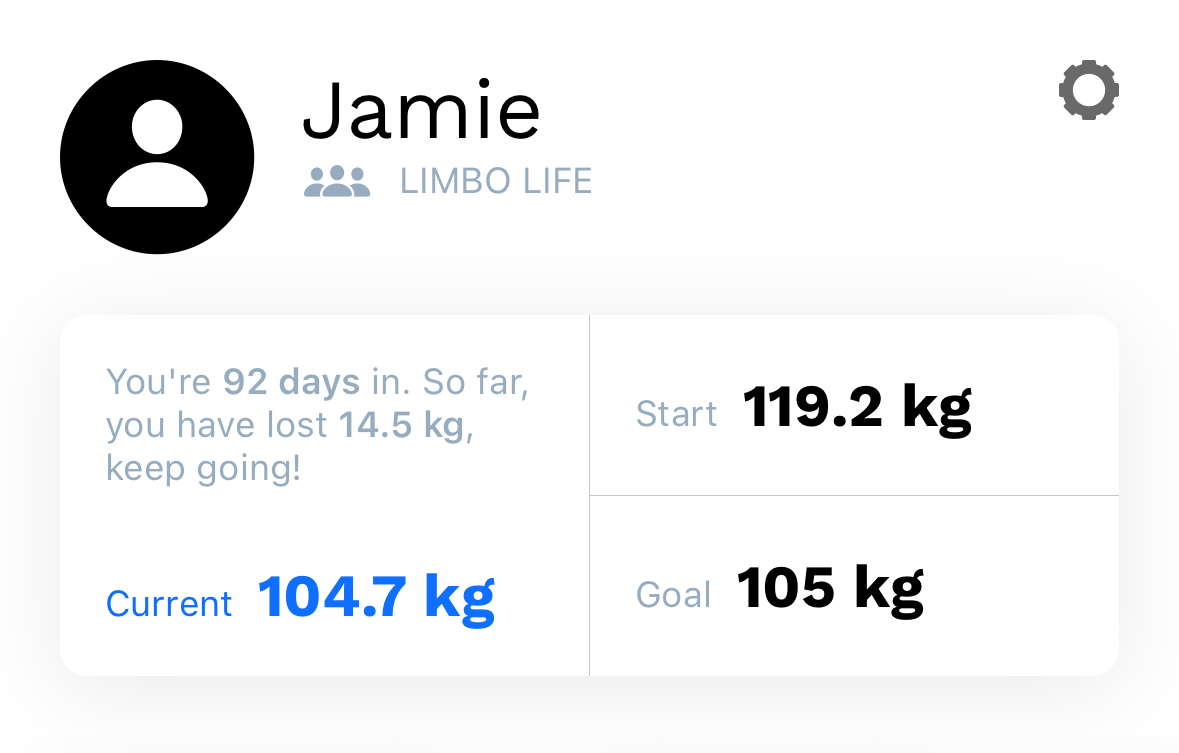
My initial goal when I started was 105kg (from a first weigh-in at 119.2kg) but that was before I knew how relatively straightforward it would be to lose that amount, or what 105kg would feel like.
I hit that goal a few days over the 3 month mark: down >14kg in 3 months (that’s ~30 pounds for the Americans) to 104.7kg.
You can see that it hasn’t been completely smooth sailing and there were regular ups & downs but when you get past the daily +/- you see a pretty consistent trend downwards.
I’m now lighter than I can remember at any time in the past 10 years. Honestly, I never remember seeing 105kg on the scales so I was probably last this weight in my 20’s or post-car accident.
There have been other effects too:
👎 I needed to find a new belt as my old one wouldn’t go small enough!
👍 but I now wear a belt my wife had bought me years ago that never really fitted me
👎 All my new t-shirts don’t fit and are hilariously baggy
👍 but I get to wear some old favourites that now fit again
I’m actually holding off buying new clothes until I reach my final destination and can rebuild the wardrobe.
I also have a healthier relationship with food now. I don’t usually feel hungry (in fact, I’m probably more satisfied after each meal than ever before) and I don’t have the same mad desire for carbs in evenings. My blood glucose is stable and consistent and I rarely spike—and when it does, it’s usually an intentional choice to eat that one roast potato or celebrate a birthday with a slice of cake.
Swimming / fitness
Prior to my ankle injury earlier this year, I typically spent >2000 calories a week swimming. i.e., I was living on an 8-day/week calorie budget which helped limit my weight gain in the past. I started this diet because I was concerned that this ankle injury would keep me out of the pool and, consequently, result in a large weight gain from the reduced calorie outlay.
Although I was out of the pool for >2 months, I’ve gradually come back with a reduced swim set. Instead of 2.5-3.5km sessions with warm-ups, drills, various endurance- or pace-focused main sets, I’ve been focusing on a very fixed set based around 400m and limiting the use of my ankle:
- 3x 400m with pull buoy (to give the ankle a break)
- 1x 400 with pull buoy and paddles
- 400m freestyle
Over time, that last 400m has translated into a “max effort 400m” and the overall distance has increased to ~3.2km by adding more 400’s.
Here’s the really interesting thing: my fitness has dramatically improved over the past 3 months.
The time for that “max effort 400” over the weeks has tumbled:
- 7:05
- 6:48
- 6:43
- 6:37
- 6:31
6:31 was a new personal best, about 6 secs faster than I’d swum in at least 4-5 years; definitely my fastest post-COVID time. And then I did 6:21. Then 6:18. This week I swam 6:17… and that was after swimming 2.8km of 400’s, all of which were faster than that first max effort of 7:05. That’s 20 secs faster 400m time than I have ever achieved!
Yesterday I swam a 1500m for a change and knocked 2m11s off my personal best (set in March this year IIRC), and along the way knocked 58s off my best 1000m time.
What in the world is happening?! I feel fucking awesome.
Is that because of the change in swim training to focus on 400’s? Was it the lack of carbs and more stable blood glucose? Or because I’ve lost ~14kg of weight, even though weight and swim performance isn’t usually so highly correlated? Or are my muscles performing better due to being a bit leaner?
I don’t know but I don’t think I can ignore that a no-carb diet has actually increased my swim performance.
I still want to try a longer endurance-focused swim, something like a 10x 400m “Red Mist” session, to see how much that hurts. I suspect without taking on any carbs/caffeine it’s going to hurt a lot but that’s why we do these things.
Edit: I swam 10x 400m today at an average 1:45/100m pace (for runners, this would be equivalent to a 10mile/16km run). That is a whole 5 secs per hundred faster than the last time I swam it in May! This was also at about 3pm, after eating breakfast at 10am, and not having eaten any carbs or caffeine to prepare. It hurt, I was tired, and I couldn’t quite match my initial pace, but I was entirely possible to do that distance without carb-loading. Unfortunately I didn’t have the sensor on but I am really curious about the blood glucose readings.
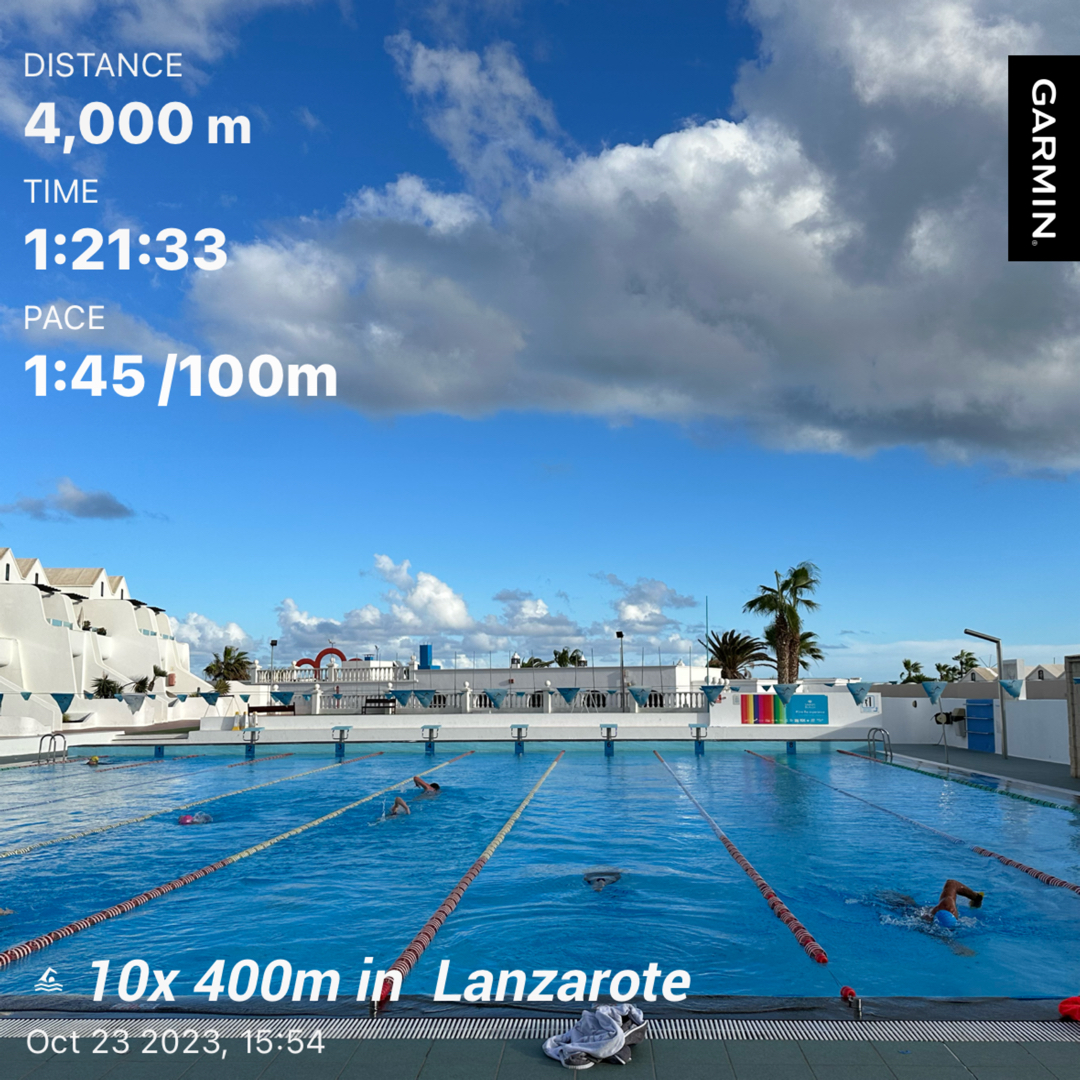
Further update: I went on to swim 10x 400m three times that week at a 1:44 - 1:45/100m pace with no carb-loading for a total of 20,000m that week—by far my biggest swim week ever. Would it have been easier with an injection of carbs and caffeine? Sure, probably, but it’s wonderful to see what the body can do without the dependence on sugar as a fuel
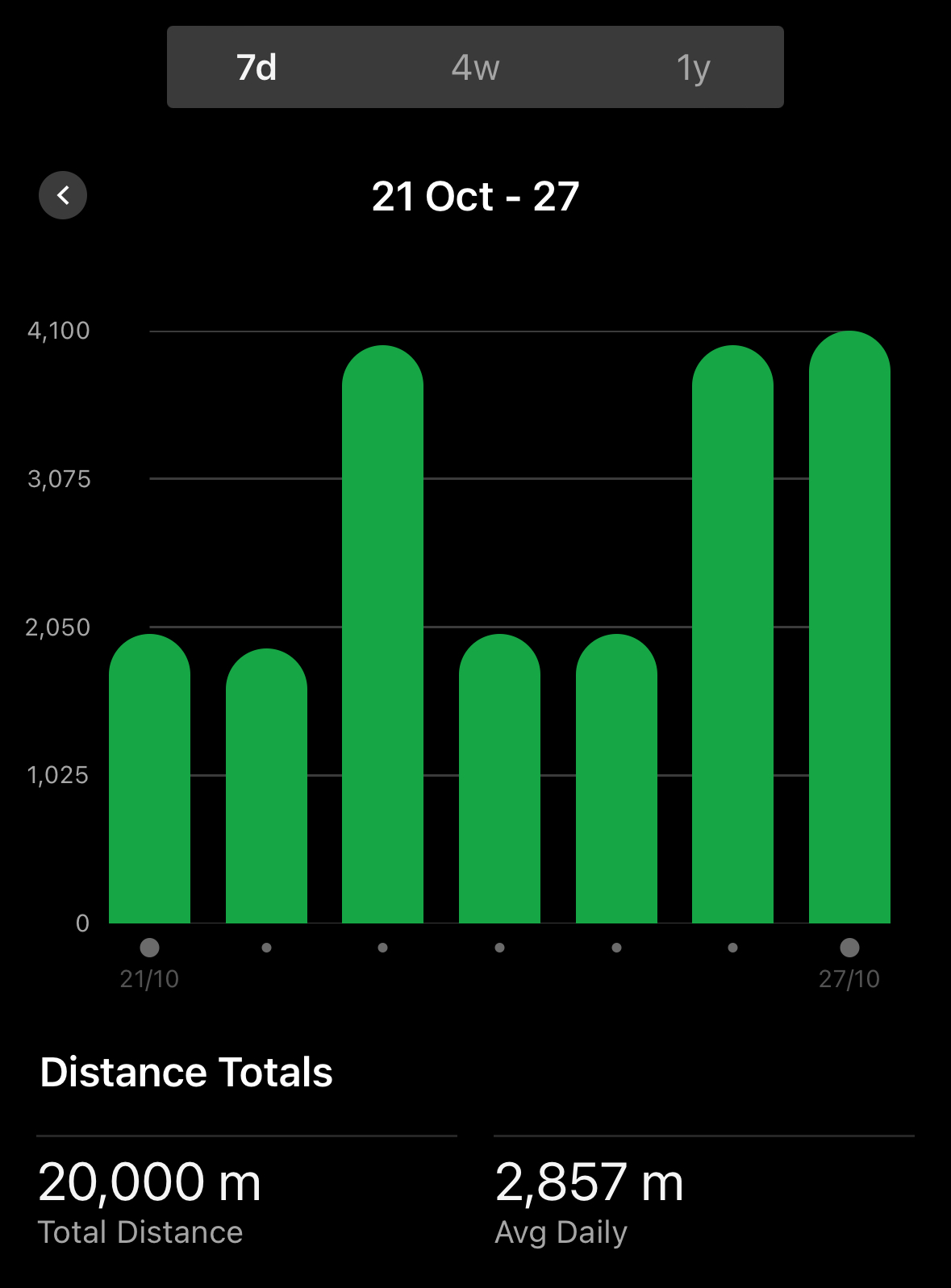
Heart health
It has not all been smooth sailing though.
I’ve had evenings and weekends curled up on the couch feeling really low-energy (the so-called “Keto-flu”). I’ve also had heart palpitations for hours at a time, on and off for days.
Sometimes in the evenings I’d sit down to watch TV and find that my heart was racing to 120-130bpm by the time I went to sleep. And it would stay that way until 4am and then suddenly drop back to a normal rate of ~65bpm. That was quite disturbing and not much fun.
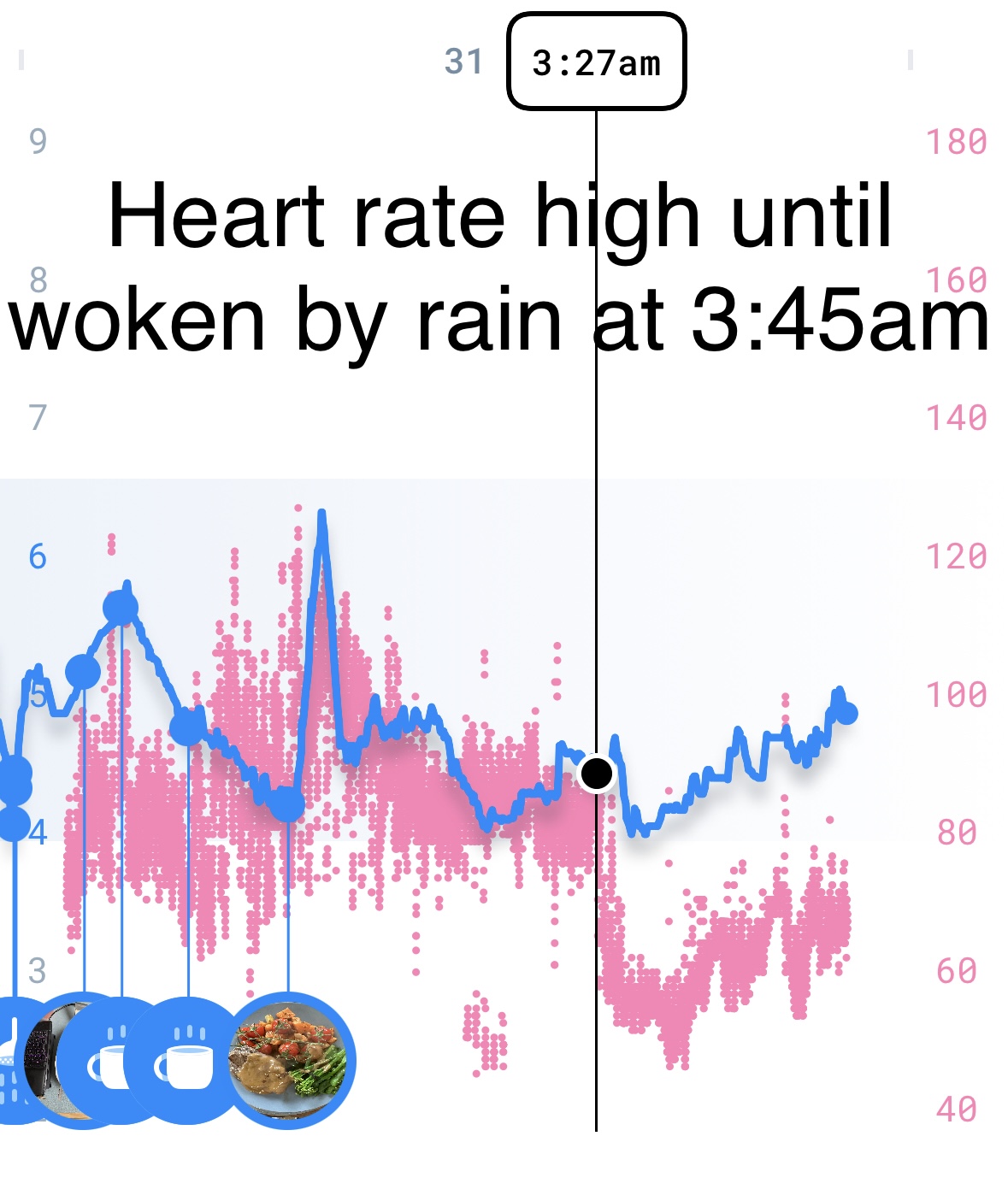
I’d read that ketosis can put more stress on the heart and palpitations are not uncommon as the body adapts to the lack of carbs—but this usually goes away after ~2 weeks. My symptoms lasted much longer and seemed to be triggered by recovery from intense exercise. I tried taking electrolytes, particularly in the afternoon/evening on a swim day to make sure I wasn’t lacking in salt; and I cut out all caffeine in case that stimulant was causing the heart to overreact.
(Yeah, so this has been 3 months with basically no carbs, no alcohol, and no caffeine. Oddly, it’s not as bad as it sounds!)
I saw my GP about the heart palpitations but I thought I had it under control by cutting out caffeine. We agreed to monitor it and for a few weeks all was fine.
Then in October, after a few hard swims (those personal bests!), I had palpitations on/off for about 5 days including this pretty stark example: ~120bpm eating breakfast then ~120bpm swimming 3km. These activities should not warrant the same heart rate!
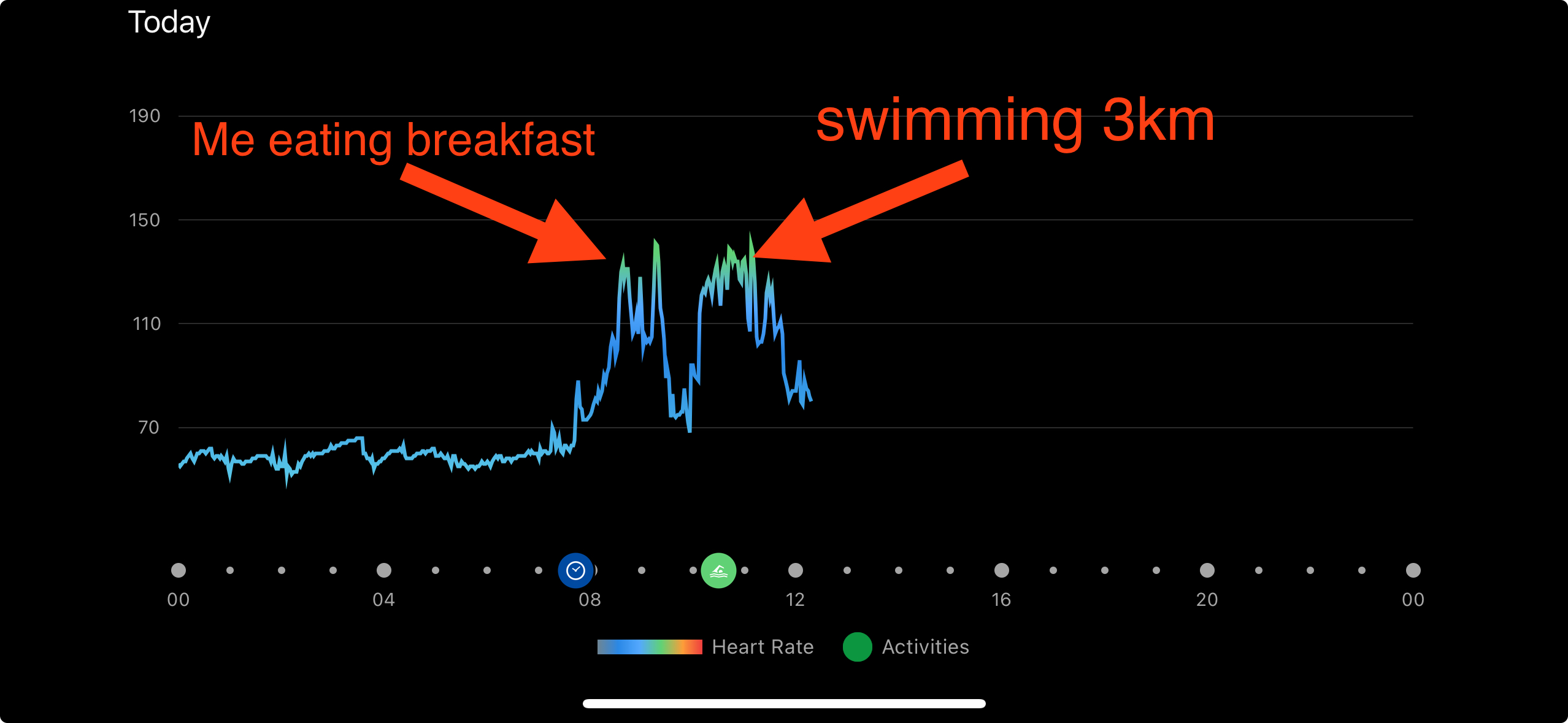
Luckily this time I could get to the GP when I was experiencing the palpitations and he thought he could detect a ectopic heart beat (basically an extra beat, caused by an electrical problem) and referred me to the priority cardiac unit. They don’t muck around and within 15mins I had an appointment to fit a 24hr Holter monitor to try to catch how the heart was behaving badly. Then I came in for a half day of detailed history, EKG, ultrasound, and stress test.
Naturally, my heart was on its best behaviour during this entire period (and ever since) and we weren’t able to catch any physical or electrical problem that might be causing the elevated heart rate. I came away with the reassurance that my heart is physically fine and the consultant was happy for me to continue with both the diet and my swimming. Throughout this whole process my physio, GP, and cardiac consultant have been incredibly supportive of the diet, losing weight, and continue to swim—even despite these symptoms.
I now have a personal EKG sensor so I can capture a trace if the symptoms return and email the results to my cardiac consultant (what a world!). We still don’t know if the palpitations are a result of the diet, an underlying problem I’ve always that’s just made worse, a result of COVID from the May, or nothing at all.
On the up-side, my resting heart rate has dropped by 10-15bpm even with the occasional racing heart! You can clearly see when I started this diet in July:
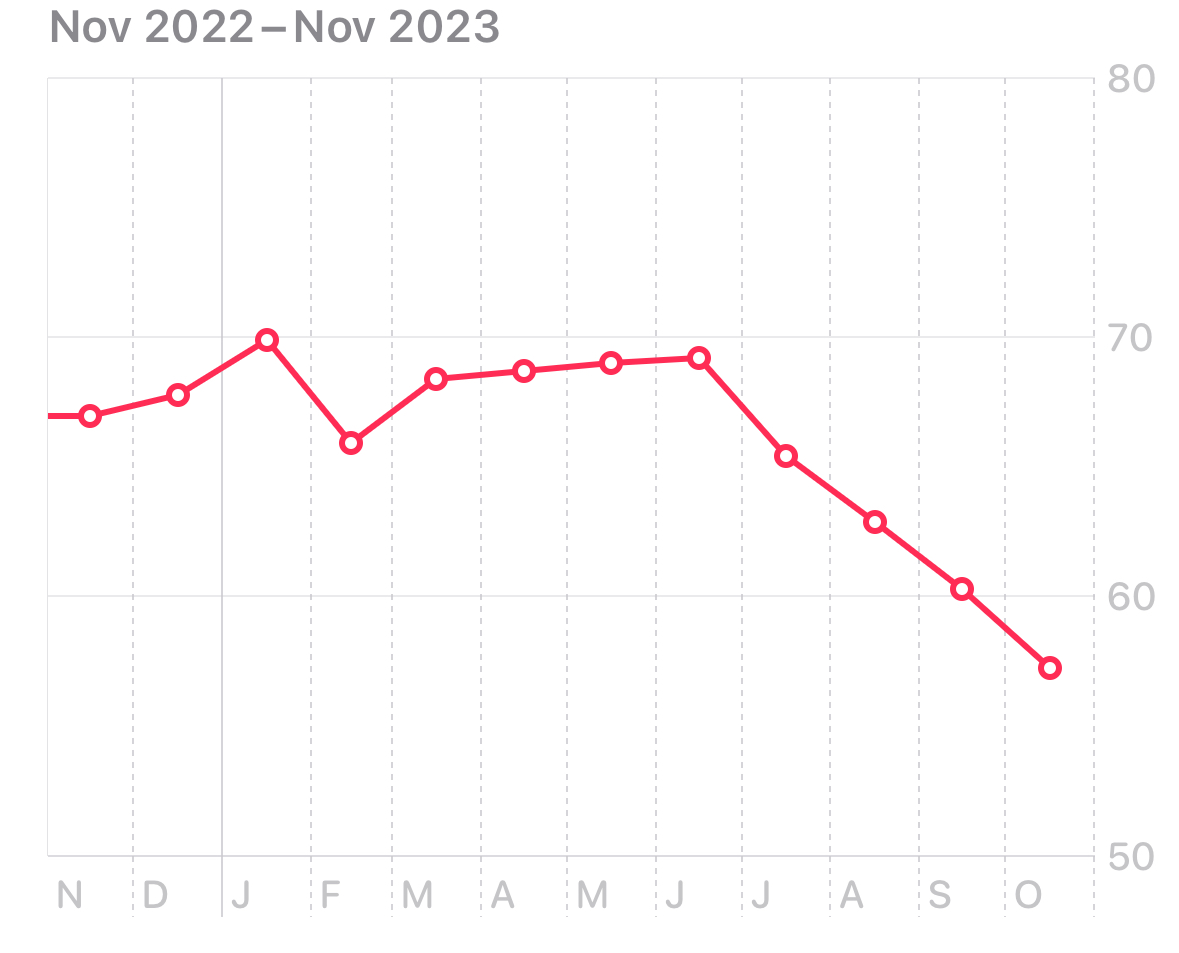
Update May ‘24: It came back much worse in the New Year and the EKG machine identified Atrial Fibrillation, usually at least once a day. It was almost certainly a result of COVID a year ago, not the diet, since I recalled having a brief episode in June last year before the diet started
Closing thoughts on Limbo itself
I would not have attempted this diet without Limbo, if only because “keto” sounded faddy and there was no feedback loop so I’d have never known what was working. The Limbo app itself has improved over the past few months now and the feedback messages are now much less condescending and a lot more educational. They have also improved some of the logistical issues around shipping sensors out each month though I hesitate to say they’ve solved them.
It’s worth noting though that Limbo is basically just a collection of consumer hardware that you can buy yourself. The scales and heart rate sensor can be replaced with any number of consumer alternatives (and Limbo will now use that data via Apple Health). The sensors and transmitter are just the same as a diabetic would use and, I believe, can be obtained without a prescription. They can be a bit unreliable though: my first transmitter only held charge for about 2 days instead of about 12; and, of the 7 sensors I’ve worn, 1 gave incorrect readings and another must have gone in wrong and was painful to touch.
This isn’t a criticism of Limbo though but a realistic summary of the state-of-the-art in glucose monitoring. The hardware is mass-produced and just doesn’t have the same quality as many other wearables.
Most of the value you get from Limbo is:
- An app that integrates blood sugar readings, heart rate, and weight.
- Feedback messages guiding you through the journey and helping to analyse good/bad food choices based on the effects they had on your blood sugar
- A supportive community with many people willing to share their tips for managing the sensors, addressing small discomforts, providing recipe ideas, giving advice about sports, and celebrating success together
I took advantage of a special offer during the summer and pay €100/mo and, at that price, I would wholeheartedly recommend it. I believe the regular price is more though. Whether that’s worth it is up to you but I think it increases your chance of success over just randomly cutting out carbs on your own. It has been a life-changing process for me.
I’m in Lanzarote this week and even though I’m not wearing a sensor this week (due to the aforementioned painful positioning of my last one), I’m still living that Limbo-life as much as possible. I’m sticking to a savoury breakfast, eating salads for lunch with as much protein as I can find, and trying to avoid carbs at dinner. Avoiding pizza, pasta, and potatoes when eating out is a challenge but I feel armed with knowledge and a change of habits now.
Limbo is not a subscription you should need for life but something you adopt to make a positive change and discard once you’re comfortable with the process. Depending on how this goes I might consider cancelling Limbo now that change has been affected, or I might keep it until I hit my new goal of 98kg which should be around the New Year.
Post-holiday update: After a week in Lanzarote ☀️ without my Limbo sensor or feedback, I came back just 0.2kg heavier (i.e., basically the same) as the day I left. This was encouraging. Even though I was away from my usual support systems and food supplies, I was able to cobble together a protein-heavy breakfast and salad most days, and mostly avoid carbs during the evenings. That said, there was wine, margaritas, mojitos, ice cream and milkshakes so I was definitely not completely virtuous. All told, coming back with no holiday weight to lose is a pretty good result.